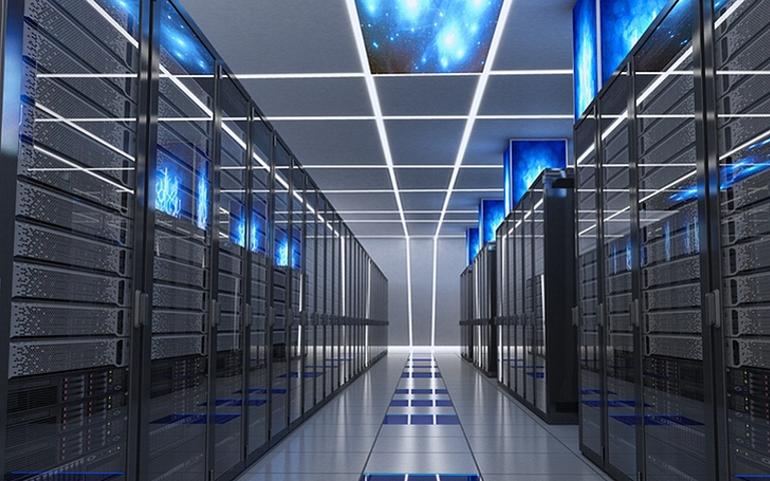Annual AI Power Consumption Rivals That of an Entire Country

By Sunny Lewis for Maximpact
AMSTERDAM, The Netherlands, October 12, 2023 (Maximpact.com Sustainability News) – The artificial intelligence (AI) industry could consume as much energy as a country the size of the Netherlands by 2027, new research shows. Data centers run 24/7 and most are powered by fossil fuels, although there are efforts to utilize renewable energy. Today, the world’s data centers account for one percent of the global electricity demand, according to the International Energy Agency and about four percent of global greenhouse gas emissions, exceeding even those of the aviation industry.
Google has been using generative AI in the company’s email service, gmail, and the company is testing out powering its search engine with AI.
If every one of Google’s nine billion searches a day used AI, the company would need about 29.2 terrawatt hours (TWh) of power each year, equivalent to the annual electricity consumption of Ireland, writes the founder of Digiconomist <https://digiconomist.net/>Alex de Vries in a commentary published October 10 in the journal “Joule.”
“Looking at the growing demand for AI service, it’s very likely that energy consumption related to AI will significantly increase in the coming years,” de Vries, a Ph.D. candidate at Vrije Universiteit Amsterdam, predicts.
By 2027, worldwide AI-related electricity consumption could increase by 85 to 134 TWh annually, writes de Vries, an amount comparable to the annual electricity consumption of the Netherlands, Argentina, or Sweden.
The term “artificial intelligence” was coined 68 years ago on August 31, 1955, in a proposal to the Rockefeller Foundation for a “study of artificial intelligence” submitted by John McCarthy of Dartmouth College, Marvin Minsky of Harvard, Nathaniel Rochester of IBM, and Claude Shannon of Bell Telephone Labs. The workshop, which happened in July and August 1956, is considered the official birthdate of AI. It has been growing by leaps and bounds ever since.
Artificial intelligence – the ability of computers to think and learn – takes many weeks or months of energy-intensive training to generate while the machines learn by processing huge amounts of data – many billions of words from the internet, printed articles and books, specialized data, charts, and images.
With initial training, the computers can process languages, solve problems, and learn even more. AI is already used in self-driving cars, healthcare management, financial investing, travel booking, social media monitoring, robots and chatbots.
Examples of AI in action this year are dramatized by robots. In Hong Kong, for instance, Hanson Robotics <https://www.hansonrobotics.com> is building humanoid robots with artificial intelligence for consumer, entertainment, service, healthcare, and research applications. Hanson has created an advanced social-learning robot named Sophia. Through AI, Sophia can communicate with natural language and use facial expressions to mimic human emotions.
In July in Geneva, the AI for Good Global Summit featured nine humanoid social robots and over 50 specialized robots in an unprecedented display. The robots showcased capabilities from fighting fires and delivering aid to providing healthcare and farming sustainably.
“We must make AI for all. We must make AI by, with, and for the people – that is: all people, enhancing and harnessing the wisdom of humanity, in order to benefit the future for all people and all life.” – said David Hanson, founder of Hanson Robotics and the Global Artificial Intelligence Association, GAIA.
With a holistic approach, GAIA drives the development of AI technology that aims to be both technically feasible and socially responsible.
“Given how powerful AI is becoming, centralized AI could create an insuperable empire dominated by a few major companies and governing bodies. We at GAIA envision an AI future without tyrannical rules and imperial dominance but with democracy flourishing. Only democracy will grant individuals equal participation and protection,” Hanson declared.
Using AI to Manage Climate Change
While needing huge amounts of power to analyze data and perform tasks, computers trained in artificial intelligence may be able to help humans mitigate and adapt to climate change. AI can be used to improve climate models and make more accurate predictions of climate-related extreme weather events, heatwaves, floods, wildfires, and drought.
In New York City, for example, Columbia University opened a new $25 million AI-based climate modeling center, Learning the Earth with Artificial Intelligence and Physics (LEAP). It will develop next-generation AI-based climate models and train a new wave of students fluent in both climate science and working with big datasets and modern machine-learning algorithms.
In collaboration with the National Center for Atmospheric Research and NASA’s Goddard Institute for Space Studies, the LEAP center will develop the next generation of data-driven, physics-based climate models. LEAP’s larger goal is to provide actionable information that societies can use to adapt to climate change and protect the most vulnerable.
“Until climate models can offer more precise projections, at the regional level where planning decisions are made, it will be difficult to make the billion-dollar investments needed to adapt,” said Columbia President Lee Bollinger. “I can think of no better university than Columbia, with its interdisciplinary focus, to lead the way in tackling the climate prediction problem.”
To accomplish these sophisticated tasks is very energy-intensive. Today’s data centers run 24/7, and most are powered by fossil fuels, although there is a recent move to use renewables. Burning all that oil, gas, and coal to run the data centers and cool them, emits a great deal of greenhouse gas.
So to balance its energy use, can AI help humans avoid the worst consequences of climate change? The answer is yes, writes Renee Cho for the Columbia Climate School newsletter.
“AI can help develop materials that are lighter and stronger, making wind turbines or aircraft lighter, which means they consume less energy. It can design new materials that use less resources, enhance battery storage, or improve carbon capture,” Cho explains.
She lists some of the functions AI can perform. “AI can manage electricity from a variety of renewable energy sources, monitor energy consumption, and identify opportunities for increased efficiency in smart grids, power plants, supply chains, and manufacturing.”
“AI systems can detect and predict methane leaks from pipelines. They can monitor floods, deforestation, and illegal fishing in almost real time. They can make agriculture more sustainable by analyzing images of crops to determine where there might be nutrition, pest, or disease problems,” writes Cho.
“AI robots have been used to collect data in the Arctic when it is too cold for humans or conduct research in the oceans. AI systems can even green themselves by finding ways to make data centers more energy efficient,” she writes hopefully.
Large language models (LLMs) are deep learning algorithms that can recognize, summarize, translate, predict, and generate content using very large datasets – and they use exorbitant amounts of electricity to do so. In 2019, University of Massachusetts Amherst researchers trained several large language models and found that training a single AI model can emit over 626,000 pounds of the greenhouse gas carbon dioxide (CO2) equivalent to the emissions of five cars over their lifetimes.
Cho reported in June on a more recent study that found training a GPT-3 language prediction model with 175 billion parameters consumed 1,287 megawatt hours of electricity, and resulted in carbon emissions of 502 metric tons, roughly equivalent to driving 112 petrol-powered cars for a year.

Danny Quinn, who heads the Scottish data centre firm DataVita, explained to the BBC this week the difference in energy use between a rack in a data centre of standard servers, and one containing AI processors.
“A standard rack full of normal kit is about 4 kilowatts (kW) of power, which is equivalent to a family house. Whereas an AI kit rack would be about 20 times that, so about 80kW of power,” Quinn said. “And you could have hundreds, if not thousands, of these within a single data centre.”
The issue worries Professor Kate Crawford of the Annenberg School for Communication and Journalism at the University of Southern California and the Microsoft Research Lab in New York City. In 2021 Yale University Press published her book “Atlas of AI,” which explores AI and its impact on the environment.
Speaking to the BBC in July, she said, “These energy-intensive systems take enormous amounts of electricity and energy, but also enormous amounts of water to cool these gigantic AI supercomputers. So we are really looking at an enormous extractive industry for the 21st Century.”
But there are also hopes that AI could help solve some of the greatest environmental challenges facing the planet. Jim Bellingham, executive director of the Johns Hopkins Institute for Assured Autonomy, is among the hopeful.
“Climate change is one of the most difficult scientific problems that humans have ever faced. It’s a phenomenally complex system with an enormous number of variables. When people talk about climate change, they tend to focus on the physical aspects of climate, such as the amount of carbon dioxide in the atmosphere, temperatures, precipitation levels, and wind patterns. But these characteristics are all shaped by a living planet that is constantly changing,” Bellingham explained.
“Climate data sets are enormous and take significant time to collect, analyze, and use to make informed decisions and enact actual policy change. Using AI to factor in elements of climate change that are constantly evolving helps us make more informed predictions about changes in the environment, so that we can deploy mitigation efforts earlier,” Bellingham said.
He believes that “AI feeds into the entire chain of activities related to transitioning from a carbon-based economy to a net carbon zero economy.”
“My hope for the future of AI is that we will be able to have a meaningful impact on predicting climate change,” Bellingham said. “As humans become more confident in AI, we will be able to rely on technology more to understand climate change and to make more accurate predictions and models. This will allow us to be more targeted in our strategies to mitigate the worst effects.”